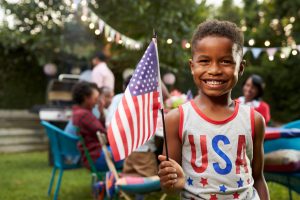 Independence Day is soon, and families are busy planning for fun that may include celebrating with fireworks, a day at the beach or a barbecue. Dr. Tony Woodward, medical director of emergency medicine at Seattle Children’s Hospital, urges families to choose safe options for a fun holiday.
Independence Day is soon, and families are busy planning for fun that may include celebrating with fireworks, a day at the beach or a barbecue. Dr. Tony Woodward, medical director of emergency medicine at Seattle Children’s Hospital, urges families to choose safe options for a fun holiday.
“The Fourth of July is a good time to follow the old advice of safety first,” said Woodward. “The last thing you want to do on the Fourth of July is be sidelined by an injury or illness that could have easily been prevented.”
Firework safety
Every year, fireworks start an average of 18,500 fires and about 10,500 people are treated in emergency departments for fireworks injuries. New research by Harborview Medical Center reviewed the cases of 294 people, ages 1 to 61, admitted to Harborview for severe fireworks injuries from 2005 to 2015. The majority of children’s injuries came from rockets, and the most serious injuries to teens were caused by homemade fireworks. Sparklers, which burn as hot as 1200 degrees, caused severe injuries to children as well.
“Sparklers and roman candles can seem fun and harmless,” said Woodward. “But every year, hospitals treat kids who have been badly burned or injured by these kinds of consumer fireworks, and these injuries are preventable.”
The safest way to enjoy fireworks is to attend a public display put on by professionals. While fireworks are illegal in many places, if you live in an area where fireworks are legal and you choose to use personal fireworks, use them with care. Woodward offers these tips:
- Only buy legal fireworks. Do not make homemade fireworks or twist legal fireworks together to multiply the effect.
- Store fireworks in a cool and dry place, away from children.
- Never let children play with or light fireworks. Insist on adult supervision if teens are allowed to use fireworks.
- Alcohol and fireworks do not mix. Designate an adult firework shooter who hasn’t been drinking or using drugs.
- Wear safety glasses for eye protection when lighting fireworks.
- Never carry fireworks in a pocket.
- Have a bucket of water and a hose nearby.
- Use fireworks outside only, in a clear area, away from buildings, cars, dry grass or brush and other things that can burn.
- Make sure bystanders are standing far away from where fireworks are being lit.
- Follow instructions closely, including lighting fireworks on smooth, level ground. Do not shoot them off in metal or glass containers.
- Do not point or throw a firework at others, and don’t hold a lit firework in your hand.
- Light only one firework at a time and move away quickly after lighting each one.
- Soak used fireworks in water before throwing them away in a nonflammable trash can outside.
- Never relight a firework that didn’t work. Wait for 20 minutes, approach carefully, and soak it in water before throwing it away.
Water safety during gatherings
Water play and swimming are often a part of the fun during summer gatherings, so it’s important to remember to pack the appropriately-sized life jackets before heading out. Children, teens and adults should always wear life jackets when on a boat, raft or inner tube, and when swimming in lakes, rivers and the ocean. Even good swimmers can be overcome by currents, cold water or becoming overly tired. Young children should also wear life jackets when playing in or near the water and when on docks.
“It’s best to swim only in areas with lifeguards,” said Woodward. “But whether in a life-guarded area or not, adults need to closely supervise children and teens in the water and ensure life jackets are worn at all times.”
Woodward says that an adult should be within arm’s reach of young children in the water at all times. Drownings happen quickly and quietly, so active supervision is needed for older kids and teens, too. Try assigning a “water watcher” to be sure that an adult is watching at all times. The water watcher should remain alcohol-free and actively watch the children in or near the water.
Food safety
Food safety is important all year long, but warmer temperatures allow bacteria to grow faster, raising the risk of food-borne illness. The U.S. Department of Agriculture (USDA) offers four steps for safe food storage and preparation during outdoor cooking:
- Clean: Bring cleaning items with you to keep hands, utensils and surfaces clean.
- Separate: Bring separate plates and cutting boards so juices from raw foods don’t contaminate cooked foods.
- Cook: Bring a food thermometer to cook foods to safe internal temperatures. You often can’t tell if meat is cooked just by looking.
- Chill: Transport meat in a cooler that is 40 degrees or below. Consider using a separate cooler for beverages since it will be opened more often. Only allow food to sit out for an hour or less.
“If you’re planning to celebrate the Fourth with family and friends, take a few minutes to think about safety to prevent a trip to the emergency room,” said Woodward. “Add sunscreen and life jackets to the packing list, buckle up for the ride, choose a designated distraction-free driver, supervise the kids and teens, and have a fun day!”
Resources:
- King 5 segment: Legal fireworks can be as dangerous as illegal fireworks
- Layers of Protection for Safe Water Fun
- Answers to questions about safe food handling, storage and preparation: AskKaren.gov
- Summer Safety Tips
- Emergency or Urgent Care?

